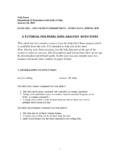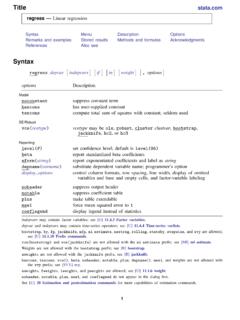Transcription of A SAS® Macro for Covariate Specification in Linear ...
1 Paper 1223-2017 A SAS Macro for Covariate Specification in Linear , Logistic, or Survival Regression Sai Liu and Margaret R. Stedman, Stanford University; ABSTRACT Specifying the functional form of a Covariate is a fundamental part of developing a regression model. The choice to include a variable as continuous, categorical, or as a spline can be determined by model fit. This paper offers an efficient and user-friendly SAS Macro (%SPECI) to help analysts determine how best to specify the appropriate functional form of a Covariate in a Linear , logistic, and survival analysis models. For each model, our Macro provides a graphical and statistical single page comparison report of the Covariate as a continuous, categorical, and restricted cubic spline variable so that users can easily compare and contrast results. The report includes the residual plot and distribution of the Covariate . You can also include other covariates in the model for multivariable adjustment. The output displays the likelihood ratio statistic, the Akaike Information Criterion (AIC), as well as other model-specific statistics.
2 The %SPECI Macro is demonstrated using an example data set. The Macro includes PROC REG, PROC LOGISTIC, PROC PHREG, PROC REPORT, and PROC SGPLOT procedures in SAS INTRODUCTION Many covariates we use i n regression models are continuous variables ( age, height, weight), but how we choose to include them in the model is at the discretion of the user. Other functional forms of the Covariate ( categorical, or spline) could be specified to improve model fit and have implications for the interpretation of the parameter estimated. Therefore, how to specify the appropriate functional form of a continuous variable is a fundamental consideration and involves a balance between model simplicity and goodness of model fit. Although there are many SAS procedures available to check data distribution, outliers, and model fit statistics, we are unaware of an existing SAS procedure that combines the above described outputs together into a one page summary report so that users can quickly compare results from different functional forms of a single Covariate .
3 This paper will introduce a customizable user-friendly SAS Macro %SPECI to quickly produce a one page report that organizes multiple commonly-used statistics to help you compare and select the appropriate functional form from continuous, categorical, and spline terms in Linear regression, logistic regression, and survival analysis models. The statistics in the final report include: Plot showing an overlay of predicted values from the three functional forms. Summary table of model statistics. (See complete list and descriptions for each model inAppendix A) Panel plot of the residual values from the model where the Covariate is continuous, categoricaland spline forms. Plot of the observed values of the Covariate and the outcome variable ( Linear and logisticregression models only) Kaplan Meier plot (survival model only). INSTRUCTIONS FOR USING Macro %SPECI There are two SAS editor programs: the main Macro ( ) and the program to call the Macro (CALL ). The call program is provided in the Appendix B and both the main Macro and the call program are available upon request from the author (Sai Liu) and are posted to the GitHub website ( ).
4 First, save the CALL and programs to your computer. Next, open CALL and update the include statement to the directory where the Macro stored %include " "; Next, specify the parameters for the Macro program (for example %let dataset= mydata) see Table 1. Macro variable Description Note datain Location your permanent SAS dataset is saved. Leave blank if your dataset is already in the work library (Default is SAS work library). When specified, include quotations, , C:\myfiles . dataout Location where one-page report will be saved This option is required. Include quotations, , C:\myfiles . dataset Name of dataset This option is required. reportname Name of one-page report Default name will be Model Diagnostic Report , if left blank. model Specify which regression model will be used in this analysis. This option is required. Choose one of the following (1-3) 1= Linear regression (prog reg) 2=logistic regression (proc logistic) 3=survival model (proc phreg) yvar outcome variable This option is required in Linear and logistic models, , %let yvar = stroke This variable should be coded as 1 for event and 0 for no event for logistic regression.
5 Leave it blank in survival model. event Outcome variable survival event or status This option is required in survival model, , %let event = death; This variable should be coded as 1 for an event and 0 for censored Leave it blank for Linear and logistic models. time2event Outcome variable survival time This option is required in survival model, , %let time2event = time_to_death; Survival times should be greater than 0. Leave it blank in Linear and logistic models. xvar_cont Covariate of interest (continuous) This option is required, , %let xvar_cont=BMI; xvar_cat Covariate of interest (categorical) This option is required, , %let xvar_cat= BMI_CAT; num_cat Number of categories for Covariate of interest This option is required, , if BMI_CAT has 4 categories, then %let num_cat= 4; Must enter a number greater than 1 ref_xvar_cat the reference category for Macro variable xvar_cat Default option will be the alphabetically last or numerically biggest category if left blank covarlist_cont List of additional continuous variables for multivariable models List each Covariate separated by a single space, %let xvar_cont = age LOS height; Leave blank if model is not adjusted.
6 Covarlist_cat List of additional categorical variables for multivariable models List each Covariate separated by a single space, %let xvar_cat = gender race cause_death; Leave blank if model is not adjusted knot Number of knots for Spline terms Default is 4 knots, if left blank Otherwise number between 3-10, , %let knot = 5; norm Normalization method 0=no normalization 1=normalization (unitless) 2=normalization (original units, default option). see CALCULATING RESTRICTED CUBIC SPLINES section for more details knot1 knot2 knot3 knot4 knot5 knot6 knot7 knot8 knot9 knot10 The percentiles of the data where the 1st-10th knots are placed The default assumes 4 knots so if left blank, the default percentiles are: knot1=P5 knot2=P35 knot3=P65 knot4=P95 knot5=blank knot6=blank knot7=blank knot8=blank knot9=blank knot10=blank The number of knots MUST match the number of percentiles for example to specify 70% %let knot1=P70 Table 1: List of Macro variable to be specified in the CALL SPECI SAS program.
7 ADDITIONAL NOTES 1. If your working dataset is already in the work library, then only the name of the dataset ( dataset ) is needed. The directory datain should be left blank. The program will automatically read the dataset from the current work library. If the dataset is permanent, give the location of your dataset in datain , so that the program will find the dataset in the assigned directory. 2. If the Covariate of interest has already been categorized in a separate variable, xvar_cat should be set equal to that variable. If the Covariate of interest has not been categorized in a separate variable, a new variable will need to be created. The categorical variable can be character or numeric. The new dataset with the new variable should be called in the Macro . 3. When additional knots are not needed, the rest of the percentile fields should be kept but left blank. For example, if you choose 4 knots in this model, and fill percentiles knot1 =P5, knot2 =P35, knot3 =P65 and knot4 =P95, then leave knot5 through knot10 blank.
8 Do not delete the blank percentiles, otherwise, the program will produce an error. 4. This Macro program only allows for a minimum of 3 and a maximum of 10 knots to be included (specified in the %RCSPLINE Macro ). CALCULATING RESTRICTED CUBIC SPLINES A number of SAS macros are available to perform restricted cubic spline analysis. In this Macro we applied %RCSPLINE (Harrell, 2004) to create the spline terms in the model. This program computes k-2 components of a cubic spline function restricted to be Linear before the first knot and after the last knot, where k is the number of knots (Croxford, R. 2016). In addition, the %RCSPLINE program provides three methods to normalize the constructed variables, where normalization means to rescale the values to the normal distribution: norm=0: no normalization of constructed variables. norm=1: divide by the cube of the difference in the last 2 knots. This normalizes the constructed variables but makes all variables unitless.
9 Norm=2: divide by square of the difference in the outer knots. This normalizes the constructed variables, but returns all the variables to their original units. (This is the default). APPLICATIONS OF %SPECI Macro WITH SAMPLE DATA In this paper, we apply a logistic regression model to the sample data as an example to illustrate the steps of how to use the %SPECI Macro and resulting output. The application of the model to Linear regression and survival models will be summarized later highlighting the differences from logistic regression. SAMPLE DATA In this paper, we analyzed data from 500 subjects in the Worcester Heart Attack Study (WHAS500, published in Hosmer & Lemeshow, 2008). These data were collected from 1975 to 2001 on all myocardial infarction (MI) patients admitted to hospitals in the Worcester, Massachusetts Standard Metropolitan Statistical Area. The WHAS500 data may be obtained from Using this data, supposed that we are interested in whether body mass index (BMI) is associated with cardiovascular disease (CVD) and how to best model the association, while adjusting for age (continuous variable) and gender (binary variable).
10 The outcome variable (CVD) is binary (0/1) representing a CVD event occurred (CVD=1) or not (CVD=0). The Covariate of interest, BMI, is continuous. Age and gender are additional covariates used to adjust the model. Using the example data, we will examine how to specify the functional form of BMI in a logistic regression model of CVD. We list the selected variables from the WHAS500 dataset in Table 2. Variable Name Description Codes / Values CVD History of Cardiovascular Disease. Outcome variable. 0=No, 1=Yes BMI Body mass index. Independent variable of interest (continuous). kg/m^2 BMI_CAT Body mass index. Created from DATA STEP. Independent variable of interest (categorical). kg/m^2 Age Age at hospital admission. Covariate . Years Gender Gender. Covariate . 0=Male, 1=Female Table 2: Description of variables used in the example analysis. Table 3 shows how to run the %CALL SPECI program using the example data. Since there is not a categorical variable for BMI in the WHAS500 dataset, we first create a new dataset with a categorical variable for BMI.


















